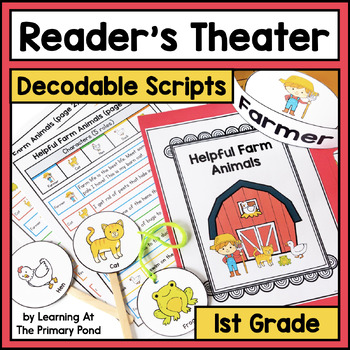Decodable Reader's Theater Plays / Readers Theatre Scripts for 1st Grade
What educators are saying
Description
This is a set of 20 decodable Reader’s Theater scripts (short plays) for first grade. Students practice and read aloud their lines for the plays, giving them an opportunity to build reading fluency and improve their communication skills! Plus, these Readers' Theatre scripts are decodable, giving students an opportunity to practice specific phonics skills.
These decodable Reader’s Theater scripts are:
- Limited in the phonics skills and high-frequency words they include - so your first graders can successfully read them
- Color-coded with clipart characters - so your students can easily follow along and know when it’s their turn to read their lines
Each Reader’s Theater script comes with a:
- Lesson plan - so you can easily introduce the script to your students and get them excited for the play
- Folder cover - so you can create re-usable sets
- Set of character headbands, plus character rounds to make necklaces or puppets - so your students can easily “get into costume”
- Color and B&W versions of all of the above
You also get these bonus resources:
- 9 different graphic organizers - so you can work on comprehension (your student “performers” and/or the “audience” can complete these)
- 2 student rubrics - so kids can self-evaluate their reading fluency and performance
- 1 teacher rubric - so you can evaluate students’ fluency and participation
The scripts cover these skills:
- VC and CVC words (3 scripts)
- Short vowels, digraphs (3 scripts)
- Short vowels, blends, double final consonants, and glued sounds (3 scripts)
- 1 and 2 syllable silent e words (4 scripts)
- R-controlled vowels and 2 syllable r-controlled vowel words (2 scripts)
- Vowel teams and 2 syllable vowel team words (5 scripts)
Frequently Asked Questions:
What scope and sequence or program do these scripts follow?
You can use these decodable scripts with any phonics program! Please see the list above of the phonics skills addressed in the scripts. These scripts are great for working on new skills or for reviewing previously-taught skills.
Will these scripts match my high frequency word instruction?
Your students can be successful reading these decodable scripts even if your high frequency word instruction is not a 100% match. Plus, each lesson plan lists out all the high frequency words / irregular words covered in the script, so you can pre-teach any words that students do not already know.
Will this cover all my phonics instruction?
No. These decodable scripts are meant to supplement a phonics program, not replace one. You will still need explicit, systematic phonics lessons to teach each sound / pattern. If you need a complete program, check out From Sounds to Spelling (available off TpT).
Do students need to memorize their scripts prior to performing?
No. The goal is for students to practice their lines multiple times so that they can confidently read from their scripts with appropriate speed, accuracy, expression, eye contact, and volume. No memorization is necessary to successfully master these reading and speaking skills.
For the Decodable Reader’s Theater for 2nd Grade, click HERE!





